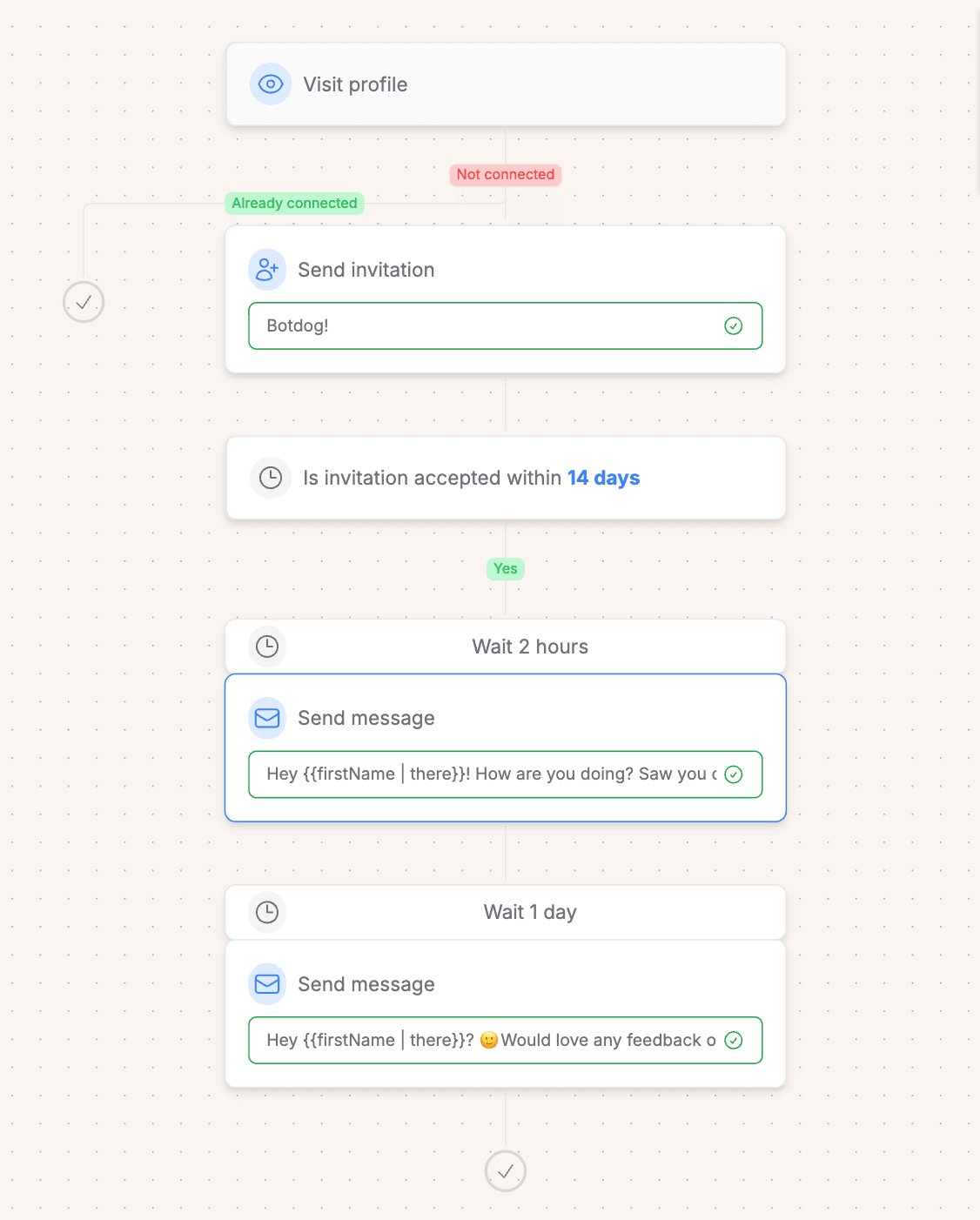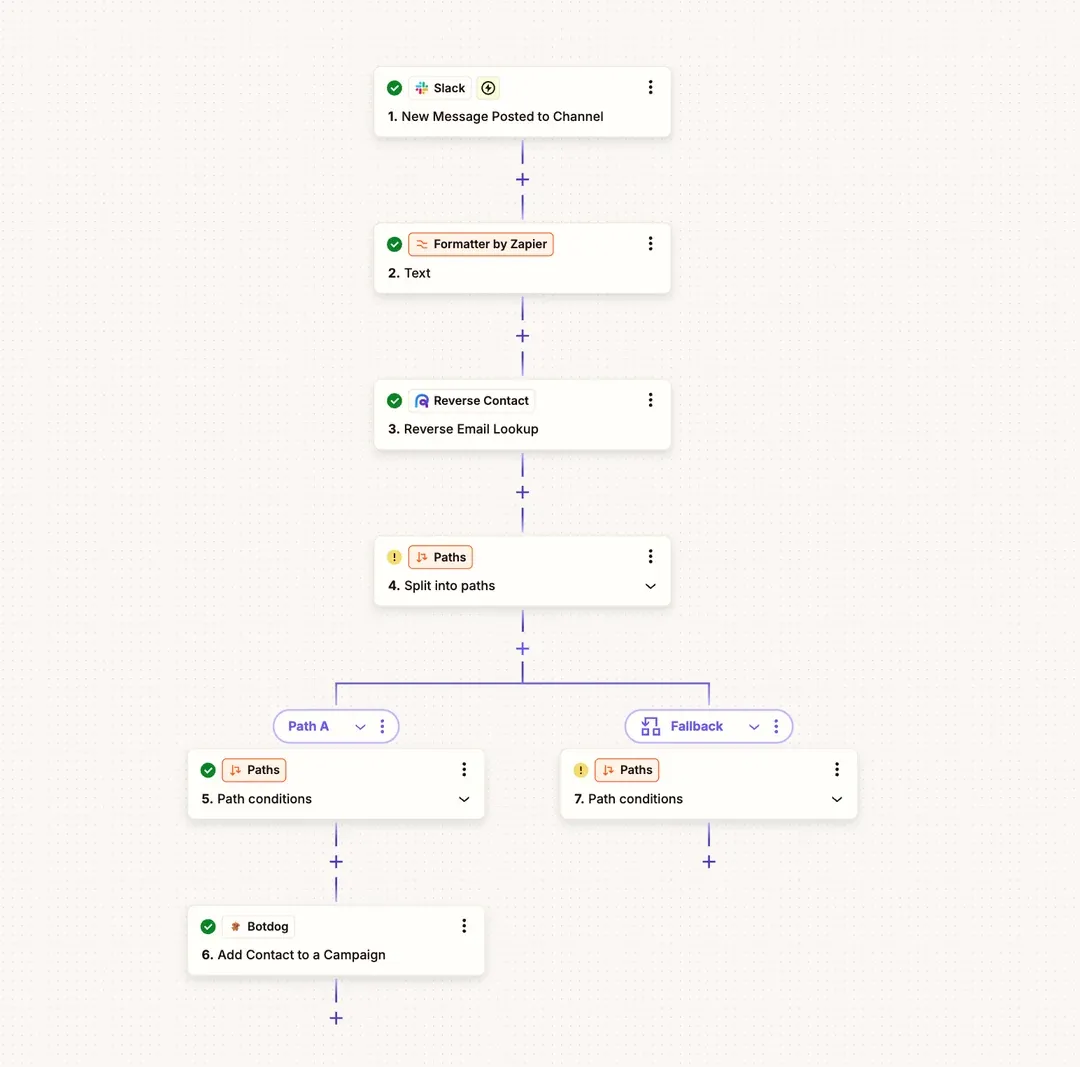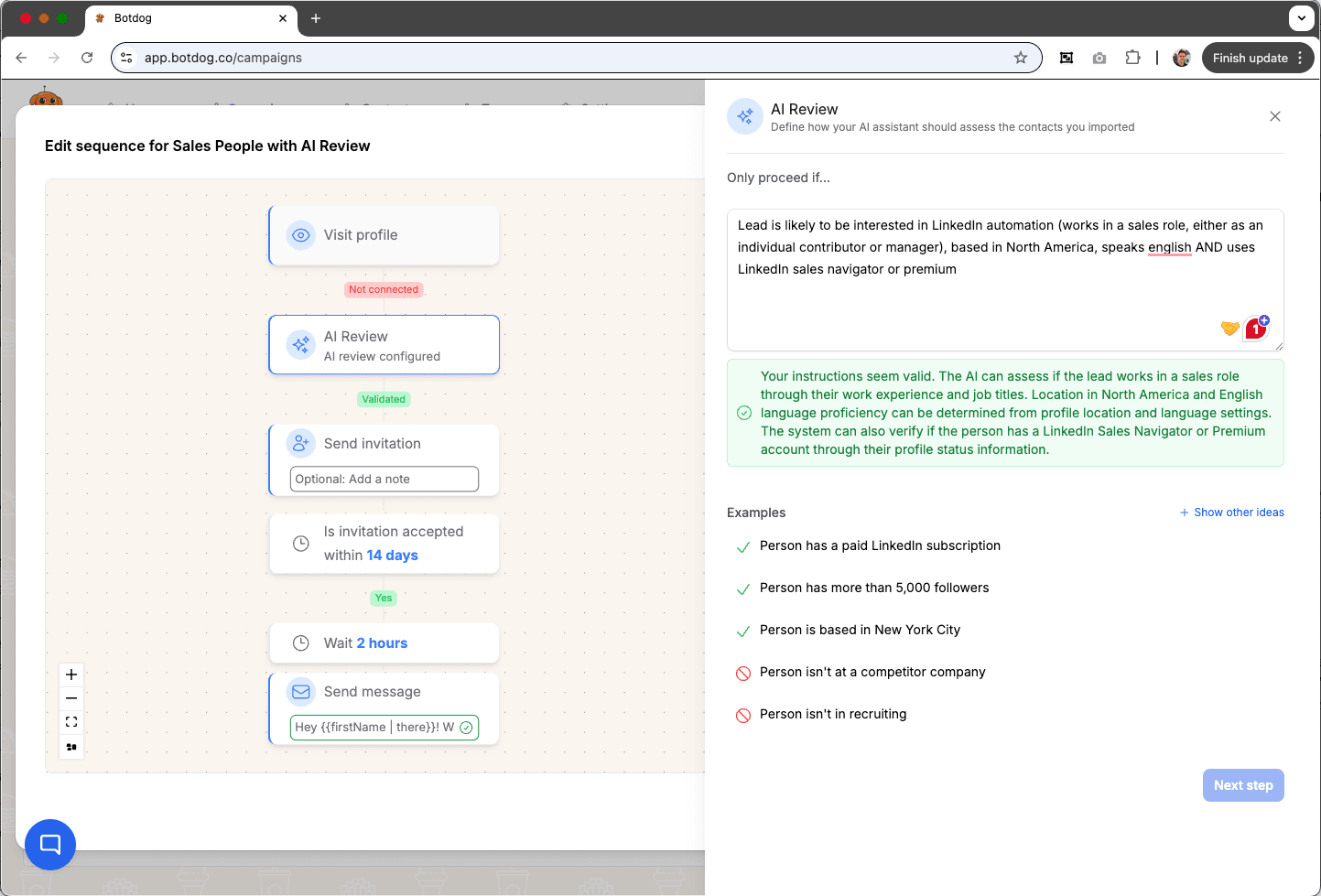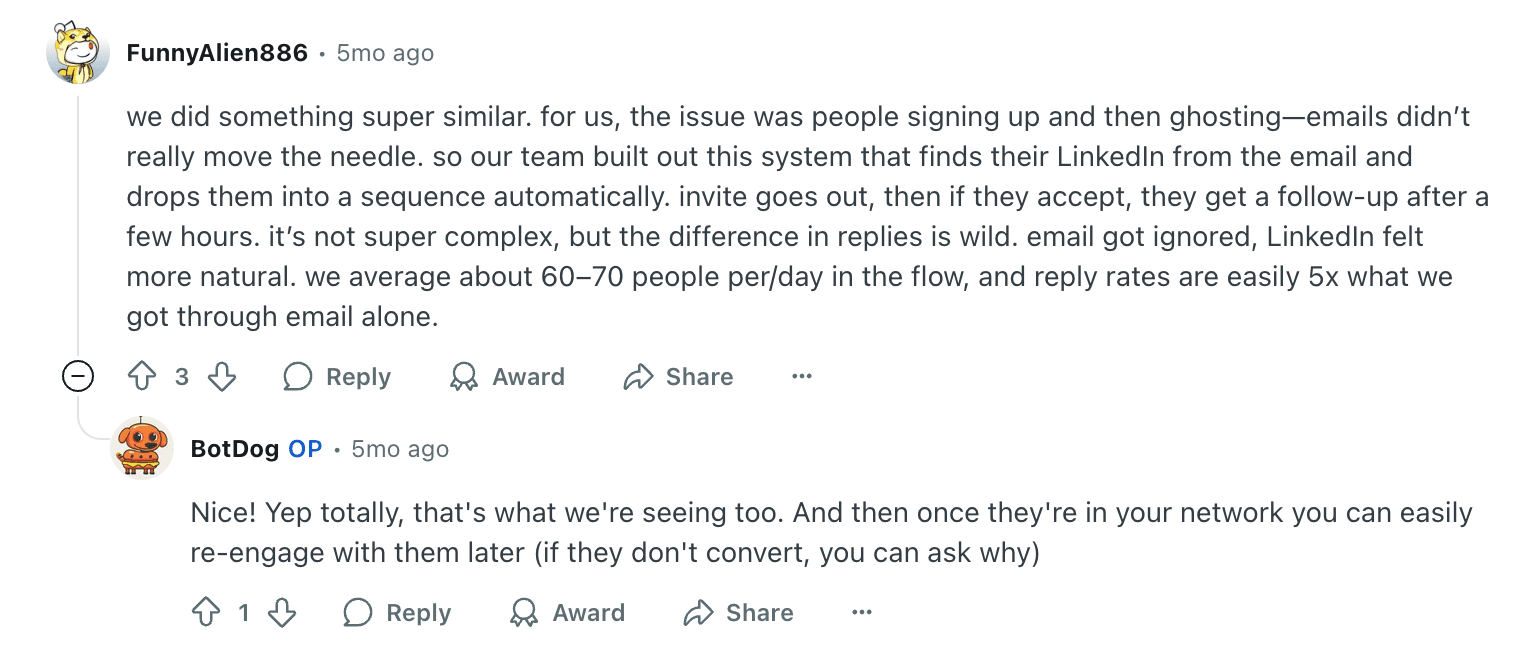Here's a statistic that should make you rethink your customer onboarding: 84% of customers accept LinkedIn connection requests from founders who reach out after signup.
Compare that to the average LinkedIn connection acceptance rate of 20-30%, and you'll understand why innovative founders are automating this exact workflow.
Since implementing this strategy at Botdog, we’ve found that the benefit isn’t just a high acceptance rate, it’s that we get to build genuine relationships with the people who matter most to our business - our customers.
Why this strategy works
Most SaaS companies treat customer acquisition like a transaction: someone signs up, they get an automated email sequence, and that's it. The relationship begins and ends in the inbox.
Meanwhile, LinkedIn sits there as an untapped goldmine for customer engagement, retention, and even conversion.
Here's what happens when you automatically connect with customers on LinkedIn:
1. Immediately prove your product works
When someone signs up for Botdog and immediately receives a connection request from the founder, they experience the product's value before they've even logged in.
Even if you're not selling automation, this first touchpoint matters. It demonstrates you're not just another faceless SaaS company - there's a real person behind the product who cares about their experience.
That’s why this strategy has an 84% acceptance rate compared to the average 20-30% for cold outreach. You're showing customers you have systems in place, you're accessible, and you're serious about their success from day one.
2. Build trust through accessibility
Think about the last SaaS product you tried. Did the founder personally reach out? Probably not.
When you connect with customers on LinkedIn, you're sending a message that says: "I'm accessible. I care about your success. You're not just another email address in our database."
This direct line to leadership matters enormously. When customers know they can reach the founder or a team member directly, they're more likely to:
- Provide valuable feedback
- Become advocates for your brand
- Convert from trial to paid subscription
- Stick with your product through early challenges
3. Boost customer retention before they even start
88% of automated LinkedIn connection request acceptances happen within the first seven days, which creates an immediate relationship foundation.
Plus, when customers accept your connection request, they start seeing your content in their feed.
Every post you share about:
- Customer wins and use cases
- Product updates and new features
- Industry insights and best practices
- Behind-the-scenes company updates
...reinforces their decision to work with you.
This constant, non-intrusive presence keeps you top of mind without being pushy. It's the difference between "I should probably cancel that trial" and "I love seeing their updates - I wouldn’t get that from their competitor.”
4. Turn customers into content engagement
When you post valuable content on LinkedIn, engagement matters as posts that spark conversations with likes, comments, and reposts gain significantly more visibility.
Who better to engage with your content than people who actually use and (hopefully) love your product?
When your customer base is in your LinkedIn network:
- They share your content with their networks
- They become organic advocates for your brand
- They comment with real experiences and testimonials
- They see your product updates and feature launches first
It's like having a built-in marketing team that actually understands your product because they use it every day.
5. Easily gather product feedback
Email surveys have notoriously low response rates. But a casual LinkedIn message to a customer you're already connected with gets a much better ROI.
"Hey Sarah! Saw you've been using [Product] for a few weeks now. What's been working well? Anything we could improve?"
Plus, as LinkedIn feels more personal than an email, customers are often more willing to share honest feedback (both positive and constructive).
6. Reduce churn through relationship building
Customers don't churn from products they love. They churn from products where:
- They feel like just another number
- They hit a blocker and can't get help
- They forget the value you're providing
- They don't see active development
LinkedIn connections solve all of these. When you're connected:
- Customers feel valued (you personally reached out)
- They see your updates (proof of active development)
- They have a direct line for support (message the founder)
- Your content reminds them of your value (constant visibility)
Instead of churning silently, customers are more likely to reach out when they hit challenges, which gives you a chance to save the relationship.
7. Improve your LinkedIn account health
One benefit that most founders overlook is that this strategy massively enhances your LinkedIn account health.
LinkedIn doesn't publicize fixed connection request limits. Premium and Sales Navigator users theoretically get 150-200 requests per week, but the actual number fluctuates based on your account's health and behavior.
LinkedIn tracks two critical metrics:
- Connection acceptance rates - how many people accept your requests
- Message response rates - how many people reply to your messages
When you're connecting with customers who just signed up for your product, you could achieve:
- 84% acceptance rates (vs. 20-30% average)
- 66% response rates (vs. 10-15% average)
LinkedIn's algorithm rewards accounts with high acceptance and response rates by granting higher weekly limits. Accounts with low rates are penalized with reduced limits because LinkedIn assumes you're "spraying and praying”.
By automating customer connections, you're:
- Proving to LinkedIn you send targeted, relevant requests
- Demonstrating genuine engagement (high response rates)
- Building account health that unlocks higher limits for all your outreach
- Creating a foundation of quality connections before expanding to cold outreach
Think of it this way: before you start aggressive prospecting campaigns, you can warm up your account with customers who actually want to connect with you.
How to set up this workflow (step-by-step)
The beauty of this strategy is its simplicity. Here's exactly how to implement it:
1/ Choose your trigger events
You can automate LinkedIn connections for multiple customer touchpoints:
High-intent triggers (start here):
- Free trial signups
- Paid subscription purchases
- Product onboarding completion
- First successful action in product (sent first campaign, created first project, etc.)
Secondary triggers (add later):
- Webinar attendee sign-ups
- Demo requests submitted
- Course enrollment confirmations
- Community/waitlist signups
Pro tip: Start with free trial signups - this is the moment when building a relationship matters most for conversion to paid.
2/ Set up email enrichment
To connect with someone on LinkedIn, you need their LinkedIn profile URL, but all you have from your signup form is an email address.
That's where email enrichment comes in.
ReverseContact is a reliable pay-as-you-go email enrichment service that finds LinkedIn profiles from email addresses:
- Cost: ~$0.06 per successful enrichment
- Hit rate: ~80% success rate
- Best for: Any volume - you only pay for successful matches
- Integration: Works seamlessly with Zapier
- Free trial: 20 requests included to test the workflow
The enrichment process searches for the LinkedIn profile associated with each email address and returns the profile URL you need for automation. Since it's pay-as-you-go, you're not locked into expensive monthly subscriptions - you only pay when it successfully finds a LinkedIn profile.
3/ Build your customer connection sequence
Once you have the LinkedIn profile URL, it's time to automate the outreach.
Here's the exact sequence that gets 84% acceptance rates and 66% response rates:
1/ Connection request:
“Hey {{firstName}}! Welcome to [Product] - excited to have you here!”
OR even simpler (often works better):
“[Product Name]!”
Short messages work well because curiosity drives acceptance. They just signed up for your product, so a brief, friendly note feels natural rather than salesy.
2/ First follow-up (2-4 hours after acceptance):
“Hey {{firstName}}! Saw you created an account on [Product] - how's it going so far for you?”
3/ Second follow-up (24 hours after first message, if no reply):
“Hey {{firstName}}! 🙂
Would love any feedback on your experience with [Product] so far!”

4/ Connect everything with Zapier
What you get for ~$89/month:
- 84% connection acceptance rates (vs 20-30% cold outreach)
- 66% message response rates (vs 10-15% email)
- Automated customer relationships at scale
- Direct feedback channel with every customer
- Improved LinkedIn account health for future prospecting
The Zapier flow:
- Trigger: New signup (Stripe subscription, website form, product signup event, etc.)
- Action 1: Send signup email to ReverseContact API
- Action 2: If LinkedIn profile found → Add to Botdog campaign
- Action 3: If no profile found → Log in spreadsheet for manual review
- Optional: Send Slack notification for successful additions
Pro tip: Many teams use Slack notifications as triggers. If your product already sends "New signup!" Slack messages, you can trigger the workflow directly from those instead of your payment processor.

5/ Scale with AI filtering (for high volume)
Even on a LinkedIn Premium/Sales Navigator account, you only get 800 connection requests per month. So, once you exceed 400-500 signups per month, you'll need to be more selective about who you connect with, especially if you’re running cold outreach campaigns from the same account.
This is where Botdog's AI lead review feature becomes critical. On our Professional + AI plan, you could add filters like:
- "Only proceed if the person has a LinkedIn Premium subscription AND works at a company with 50+ employees"
- "Only send requests to people with decision-maker titles (CEO, Founder, VP, Director, Head of) at B2B companies"
- "Prioritize people who have posted on LinkedIn in the last 30 days"
These filters ensure you're using your limited connection requests on customers most likely to become advocates, provide valuable feedback, and convert to paid plans.

What other founders are seeing
You don't have to take our word for it; other founders have seen similar results.

LinkedIn outreach converts at 5-6x the rate of traditional email because it feels more personal and natural. Customers expect automated emails and have been trained to ignore them, but a LinkedIn connection from a founder or team member often comes as a surprise. It feels human and intentional, even when it's automated.
Common objections (and why they're wrong)
"Won't this feel spammy?"
Think about it from the customer's perspective - they just signed up for your product, so a connection request from the founder isn't spam; it shows you care about their success.
Our 84% acceptance rate proves that customers appreciate this outreach. They’re conditioned to ignore automated emails, but a LinkedIn connection feels intentional and human.
"I don't have time to respond to hundreds of messages."
That's the beauty of automation. The initial connection request and first message are automated. You only need to engage when customers reply - which is a good problem to have.
Companies processing 20-30 new customers per day through this workflow aren't drowning in responses. They're having meaningful conversations with engaged customers who actually want to talk.
"What if I run out of connection requests?"
LinkedIn's weekly limits (100-200 requests depending on account type) force you to be strategic about who you connect with. Start small with your highest-intent customers (paid subscriptions), then scale with AI filtering as you grow. Botdog’s AI lead review feature lets you maintain quality while increasing volume.
When you reach high volume:
- Prioritize paid customers over free trials (or vice versa, depending on your conversion and churn rates).
- Connect with power users showing high engagement
- Focus on customers in your ICP (company size, role, industry)
- Filter for active LinkedIn users (posted in last 30 days)
This way, you're strategic about who you connect with, ensuring every connection has maximum impact.
"What about privacy and GDPR?"
You're connecting with people who voluntarily signed up for your product and provided their email address. You're not scraping or buying data; you're using information they gave you to build a relationship on a professional network.
ReverseContact's enrichment complies with GDPR and CCPA laws. They don't maintain databases - they retrieve all data using publicly available OSINT methods.
That said, always give customers control. Include an easy opt-out in your terms or make it simple to decline the connection. The 84% acceptance rate shows the vast majority welcome this outreach.
Getting started: follow our 30-day roadmap
Week 1: Foundation
- Choose your initial trigger event (start with trial signups)
- Set up ReverseContact account and test enrichment
- Create Botdog account and build your first campaign
- Set up basic Zapier workflow
Week 2: Launch & monitor
- Start sending requests to new signups
- Track acceptance and response rates
- Engage with customers who reply
- Document your workflow for team use
Week 3: Optimization
- Analyze which customer segments respond best
- Refine your message templates based on feedback
- A/B test different connection request approaches
- Expand to additional trigger events (onboarding milestones, etc.)
Week 4: Scale
- Add AI filtering for high-volume scenarios
- Implement churn prevention sequences
- Create content strategy for connected customers
- Set up feature launch announcement workflows
The bottom line
Most SaaS companies treat customer acquisition as a funnel that ends at signup. But the real opportunity lies in building genuine relationships with the people who have already chosen your product.
By automatically connecting with every trial signup or new paid customer, you're not just increasing acceptance rates. You're:
- Building trust through accessibility with a direct line to the founders
- Creating warm relationships with customers instead of cold databases full of emails
- Gathering valuable feedback naturally through real conversations, not surveys
- Turning customers into active brand advocates when they see and engage with your content
- Reducing churn before it happens
And you're doing it all automatically with a workflow that takes around 60 minutes to set up and runs indefinitely.
Total investment: ~$89/month for 400 signups
Expected results: 84% acceptance rates, 66% response rates, stronger customer relationships, higher retention, lower churn, more advocates
The only question is: are you ready to stop treating your customers like email addresses and start building real relationships?
Start automating customer connections today
Botdog makes this entire workflow simple. With LinkedIn-focused automation, AI filtering, and safety features built in, you can:
- Set up sequences in under 3 minutes
- Automatically connect with customers at scale
- Track acceptance and response rates in real-time
- Scale with AI-powered filtering as you grow
Start your 7-day free trial and see why 1,000+ people use Botdog to transform customer relationships on LinkedIn. No credit card required. Set up in minutes. Cancel anytime.


